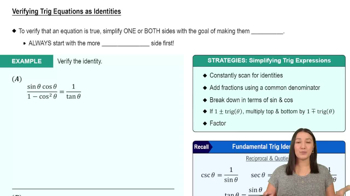Table of contents
- 0. Functions7h 52m
- Introduction to Functions16m
- Piecewise Functions10m
- Properties of Functions9m
- Common Functions1h 8m
- Transformations5m
- Combining Functions27m
- Exponent rules32m
- Exponential Functions28m
- Logarithmic Functions24m
- Properties of Logarithms34m
- Exponential & Logarithmic Equations35m
- Introduction to Trigonometric Functions38m
- Graphs of Trigonometric Functions44m
- Trigonometric Identities47m
- Inverse Trigonometric Functions48m
- 1. Limits and Continuity2h 2m
- 2. Intro to Derivatives1h 33m
- 3. Techniques of Differentiation3h 18m
- 4. Applications of Derivatives2h 38m
- 5. Graphical Applications of Derivatives6h 2m
- 6. Derivatives of Inverse, Exponential, & Logarithmic Functions2h 37m
- 7. Antiderivatives & Indefinite Integrals1h 26m
- 8. Definite Integrals4h 44m
- 9. Graphical Applications of Integrals2h 27m
- 10. Physics Applications of Integrals 2h 22m
6. Derivatives of Inverse, Exponential, & Logarithmic Functions
Derivatives of Inverse Trigonometric Functions
Problem 3.10.11
Textbook Question
Find the slope of the curve y=sin-1 x at (1/2, π/6) without calculating the derivative of sin-1 x.
 Verified step by step guidance
Verified step by step guidance1
Step 1: Recognize that the slope of the curve at a given point is the derivative of the function at that point. Here, we need the derivative of \( y = \sin^{-1}(x) \).
Step 2: Use the identity \( y = \sin^{-1}(x) \) implies \( \sin(y) = x \). Differentiate both sides with respect to \( x \).
Step 3: Apply implicit differentiation. The derivative of \( \sin(y) \) with respect to \( x \) is \( \cos(y) \cdot \frac{dy}{dx} \), and the derivative of \( x \) is 1.
Step 4: Set up the equation from implicit differentiation: \( \cos(y) \cdot \frac{dy}{dx} = 1 \). Solve for \( \frac{dy}{dx} \) to find \( \frac{dy}{dx} = \frac{1}{\cos(y)} \).
Step 5: Evaluate \( \cos(y) \) at the point \( (1/2, \pi/6) \). Since \( y = \pi/6 \), \( \cos(\pi/6) = \sqrt{3}/2 \). Substitute this into the expression for \( \frac{dy}{dx} \) to find the slope.
 Verified video answer for a similar problem:
Verified video answer for a similar problem:This video solution was recommended by our tutors as helpful for the problem above
Video duration:
4mPlay a video:
Was this helpful?
Key Concepts
Here are the essential concepts you must grasp in order to answer the question correctly.
Inverse Functions
Inverse functions reverse the effect of the original function. For example, if y = sin(x), then x = sin<sup>-1</sup>(y) is the inverse function. Understanding how to work with inverse functions is crucial for analyzing their properties, such as slopes and behavior at specific points.
Recommended video:

Inverse Cosine
Slope of a Curve
The slope of a curve at a given point represents the rate of change of the function at that point. It can be interpreted as the tangent line's steepness at the point of interest. For the curve y = sin<sup>-1</sup>(x), finding the slope at (1/2, π/6) involves understanding the relationship between the function and its inverse.
Recommended video:

Summary of Curve Sketching
Trigonometric Identities
Trigonometric identities are equations involving trigonometric functions that hold true for all values of the variables. In this context, knowing the values of sin and cos at specific angles, such as π/6, is essential for determining the slope without directly calculating the derivative. These identities help relate the angles to their sine and cosine values.
Recommended video:

Verifying Trig Equations as Identities

 7:26m
7:26mWatch next
Master Derivatives of Inverse Sine & Inverse Cosine with a bite sized video explanation from Callie
Start learning



